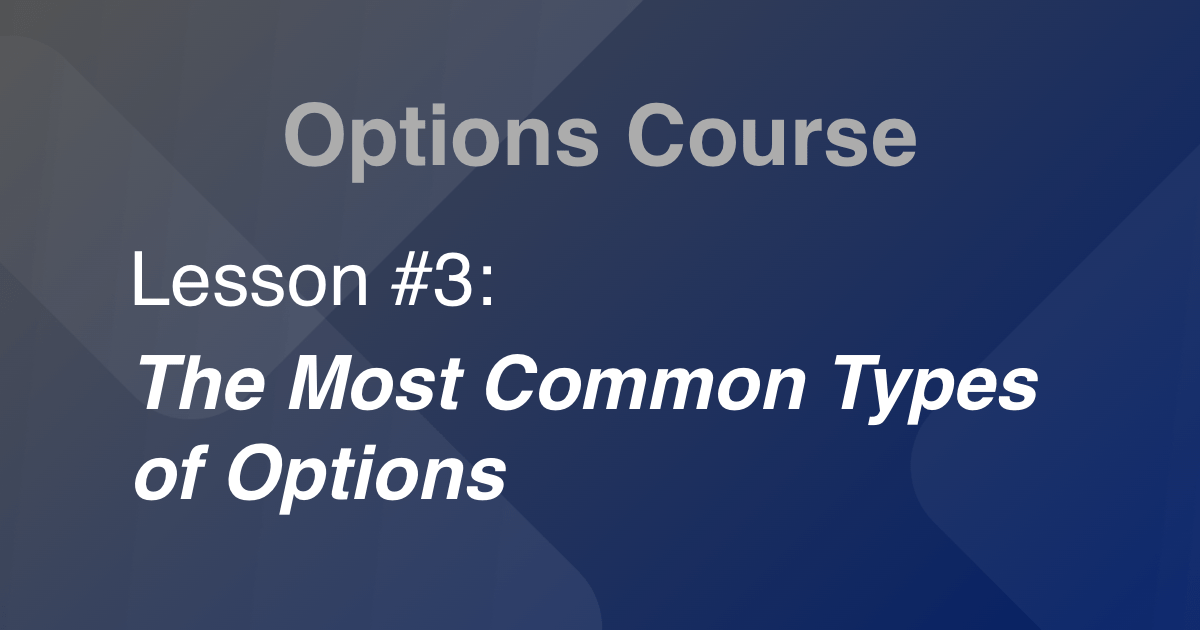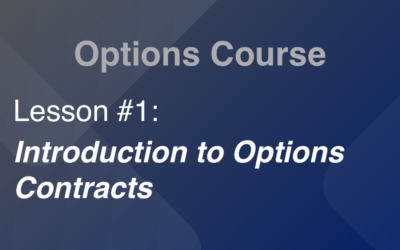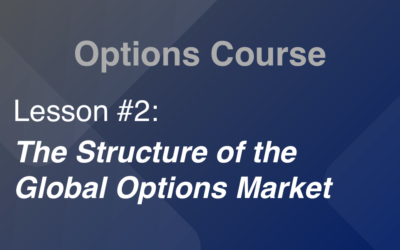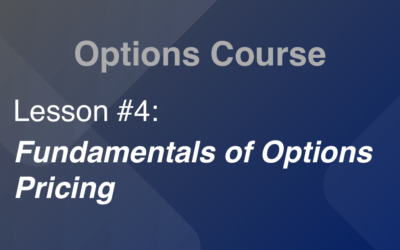Almost anything with a random outcome can have an option on it. Note that by using the word anything, we are implying that the underlying does not even need to be an asset. In this lesson we will learn about the many types of options, which are distinguished by the nature of the underlying. Although the focus of this reading is on financial options, it is also necessary to be aware of other types of options which we discuss at the end of the reading.
This reading is part of our introductory options course. Please check out the full overview of lessons here.
1. Financial Options
Financial options are options in which the underlying is a financial asset, an interest rate, or a currency.
1.1 Stock Options
Options on individual stocks, also called equity options, are among the most popular. Exchange-listed options are available on the most widely traded stocks and an option on any stock can potentially be created on the over-the-counter market.
1.2 Index Options
Stock market indexes are well-known not only among investors, but also among many people who are not directly involved in the market. Because a stock index is merely an artificial portfolio of stocks, it is logical to assume that an option on a stock index might be created.
For example, consider options on the S&P 500 Index, which trade on the Chicago Board Options Exchange and have a designated index contract multiplier of 100. On a given day, the S&P 500 closed at 3,000. A call option with an exercise price of $3,050 expiring in one month was selling for $70. The option is a European-style alternative that settles in cash. The underlying, the S&P 500, is treated as if it were a $3,000 share of stock that may be purchased for $3,050 utilizing the call option at expiration in one month. If the option is in-the-money at expiration, the buyer exercises it, and the writer pays the buyer the difference between the index value at expiration and $3,050, multiplied by the 100 contract multiplier.
There are also options on the Dow Jones Industrial Average, the Nasdaq, and numerous other indices in the United States. In most countries, there are almost always options on the most well-known stock indices.
1.3 Bond Options
Options on bonds, also known as bond options, have traditionally been traded in over-the-counter markets. Corporate bonds are rarely traded; most are bought and held until they expire. Government bonds, on the other hand, are heavily traded. Individual investors, who are significantly more interested in and knowledgeable about stocks than bonds, account for a large portion of the trading volume on options exchanges.
As a result, bond options are nearly always traded over-the-counter and are virtually always on government bonds. Consider a 20-year Treasury bond from the United States. The bond is selling for $96.17 per $100 par, with a coupon of 2.50 percent and a yield of 2.75 percent. A put or call option on the bond with an exercise price of $97 per $100 par might be sold by an over-the-counter options dealer. The option could be European or American. Its expiration date must be well ahead of the bond’s maturity date. Otherwise, as the bond approaches maturity, its price will move toward par, thereby removing much of the uncertainty in its price. The option could be specified to settle with actual delivery of the bond or with a cash settlement. The parties would additionally indicate that the contract covered a specific notional principal, which would be represented in terms of the underlying bond’s face value.
Continuing the example, let us assume that the contract covers $5 million face value of bonds and is cash settled. Suppose the buyer exercises a call option when the bond price is at $99. Then the option is in-the-money by $99 – $97 = $2 per $100 par. The seller pays the buyer $2 * $5,000,000 / 100 = $100,000. If instead the contract called for delivery, the seller would deliver $5 million face value of bonds, which would be worth $5,000,000 * $99 / 100 = $4,950,000. The buyer would pay $5,000,000 * $97 / 100 = $4,850,000. Because the option is created in the over-the-counter market, the option buyer would assume the risk of the seller defaulting.
Despite the fact that bond options are not very widely traded, another type of related option is widely used, especially by corporations. This family of options is called interest rate options. Because the underlying is not a specific financial product, these are substantially different from the other alternatives we’ve explored thus far.
1.4 Interest Rate Options
In this reading, we cover options on LIBOR. Although these are not the only interest rate options, their characteristics are sufficiently general to capture most of what we need to know about options on other interest rates.
A Eurodollar is a dollar deposited outside of the United States. The primary Eurodollar rate is LIBOR, and it is considered the best measure of an interest rate paid in dollars on a nongovernmental borrower. These Eurodollars represent dollar-denominated time deposits issued by banks in London borrowing from other banks in London.
Let us begin by studying forward rate agreements (FRA) before examining the characteristics of interest rate options. FRAS are forward contracts that pay off based on the difference between the underlying rate and the fixed rate embedded in the contract when it is constructed.
For example, consider a 3 X 9 FRA. This agreement will expire in three months. Six-month LIBOR is the underlying rate. As a result, the underlying Eurodollar instrument matures in nine months when the contract is created. The payout is made immediately when the contract expires, but the rate on which it is based, 180-day LIBOR, is fixed in the spot market, with the assumption that interest will be paid 180 days later. As a result, the payout on a FRA is discounted by the 180-day LIBOR spot rate to provide the payoff a present value as of the expiration date.
An interest rate option is a forward contract with an interest rate as the underlying, similar to how a FRA is a forward contract with an interest rate as the underlying. It has an exercise rate (or strike rate) instead of an exercise price, which is represented on the order of magnitude of an interest rate. The difference between the market’s underlying rate and the exercise rate determines the option payment upon expiration. An interest rate option is the right to make one interest payment and receive another, whereas a FRA is a commitment to make one interest payment and receive another at a later period.
Just as there are call and put options, there is also an interest rate call and an interest rate put.
An interest rale call is an option in which the holder has the right to make a known interest payment and receive an unknown interest payment. The underlying is the unknown interest rate. If the unknown underlying rate turns out to be higher than the exercise rate at expiration, the option is in-the-money and is exercised; otherwise, the option simply expires.
An interest rate put is an option in which the holder has the right to make an unknown interest payment and receive a known interest payment. If the unknown underlying rate turns out to be lower than the exercise rate at expiration, the option is in-the-money and is exercised; otherwise, the option simply expires.
All interest rate option contracts have a defined size, known as the notional principal in FRAs. Interest rate options might be European or American type, though European style is the most common. Interest rate options are settled in cash.
As with FRAs, these options are offered for purchase and sale by dealers, which are financial institutions, usually the same ones who offer FRAs. These dealers provide rates for options with a variety of exercise prices and expiration dates. When a dealer buys an option, it frequently hedges the risk with another transaction, such as Eurodollar futures.
To use an example, consider options expiring in 90 days on 180-day LIBOR. The option buyer specifies whatever exercise rate he desires. Let us say he chooses an exercise rate of 1.0 percent and a notional principal of $10 million.
Now let us move to the expiration day. Suppose that 180-day LIBOR is 1.25 percent. Then the call option is in-the-money. The payoff to the holder of the option is
$10,000,000 * (0.0125 – 0.01) * (180 / 360) = $12,500
This money is not paid at expiration; instead, it is paid 180 days later. There’s no reason why the payment couldn’t be made at expiration, as with a FRA. Interest rate options’ payment delay makes more sense because these instruments are widely used to hedge floating-rate loans, in which the rate is set on a specific day but the interest is paid later.
The difference between the underlying rate and the exercise rate is multiplied by 180/360 to reflect the fact that the rate quoted is a 180-day rate but is stated as an annual rate. Also, the interest calculation is multiplied by the notional principal.
In general, the payoff of an interest rate call is:
Notional Principal * Max (0, Underlying rate at expiration – Exercise rate) * (Days in underlying rate / 360)
The payoff of a call option at expiration is based on the maximum of zero or the underlying minus the exercise rate. If the option expires out-of-the-money, then “Underlying rate at expiration – Exercise rate” is negative; consequently, zero is greater. Thus, the option expires with no value. If the option expires in-the-money, “Underlying rate at expiration – Exercise rate is positive. Thus, the option expires worth this difference multiplied by the notional principal and the Days/360 adjustment. The expression “Days in underlying rate, refers to the fact that the rate is specified as the rate on an instrument of a specific number of days to maturity, such as a 90-day or 180-day rate, thereby requiring that we multiply by 90/360 or 180/360 or some similar adjustment.
For an interest rate put option, the general formula is:
Notional Principal * Max (0, Exercise rate – Underlying rate at expiration) * (Days in underlying rate / 360)
For an exercise rate of 1.0 percent and an underlying rate at expiration of 1.25 percent, an interest rate put expires out-of-the-money. Only if the underlying rate is less than the exercise rate does the put option expire in-the-money.
As noted above, borrowers often use interest rate call options to hedge the risk of increasing rates on floating-rate loans. Lenders often use interest rate put options to hedge the risk of decreasing rates on floating-rate loans. The form we have seen here, in which the option expires with a single payoff, is not the most commonly used variety of an interest rate option. Multiple interest payments are common with floating-rate loans. Each of these payments has a specific due date. To protect against rising interest rates, the borrower would require options that would expire on each rate reset date. As a result, the borrower will need a mix of interest rate call options. Similarly, on a multiple-payment floating-rate loan, a lender would need a mixture of interest rate put options to hedge the risk of falling rates.
A combination of interest rate calls is referred to as an interest rate cap or sometimes just a cap. A combination of interest rate puts is called an interest rate floor or sometimes just a floor.
An interest rate cap is a series of call options on an interest rate, with each option expiring at the date on which the floating loan rate will be reset, and with each option having the same exercise rate. Each option is independent of the others; thus, exercise of one option does not affect the right to exercise any of the others. Each component call option is called a caplet.
An interest rate floor is a series of put options on an interest rate, with each option expiring at the date on which the floating loan rate will be reset, and with each option having the same exercise rate. Each component put option is called a floorlet. The price of an interest rate cap or floor is the sum of the prices of the options that make up the cap or floor.
A special combination of caps and floors is called an interest rate collar. An interest rate collar is a combination of a long cap and a short floor or a short cap and a long floor. Consider a borrower with a variable rate loan who wishes to hedge against rising interest rates but is concerned about the need that the hedge be paid for up front: the option premium. A collar, which adds a short floor to a long cap, can help to reduce or even eliminate the cap’s initial cost. The selling of the floor generates cash, which lowers the cap’s cost. It is possible to arrange the exercise rates so that the price collected for the sale of the floor exactly offsets the price paid for the cap, removing the up-front expense totally. This transaction is sometimes called a zero-cost collar. However, the term is a little deceptive, and it emphasizes the need of knowing the exact cost of a collar. When rates are high, the borrower can be compensated from call options, but when rates are low, the borrower must pay the counterparty. As a result, protecting against rising rates comes at the expense of losing the benefit of lowering rates. Caps, floors, and collars are common interest rate market mechanisms.
Although LIBOR, Euribor, and Euroyen are the most common interest rates used in interest rate options, the underlying can be any interest rate.
1.5 Currency Options
A currency option allows the holder to buy (in the case of a call) or sell (in the case of a put) an underlying currency at a pre-determined exercise rate, which is stated as an exchange rate.
Many companies, knowing that they will need to convert a currency X at a future date into a currency Y, will buy a call option on currency Y specified in terms of currency X. Let’s imagine a corporation in the United States needs €100 million in three months for an expansion project. As a result, it will be purchasing euros, putting it at risk of the euro increasing against the dollar. Despite this concern, it would prefer to benefit if the euro fell in value against the dollar. As a result, it may purchase a euro call option. Let’s say it stipulates a $1.20 exercise rate. As a result, it pays cash up front for the right to buy €100 million at a $1.20 per euro exchange rate. If the option expires with the euro over $1.20, the company can buy euros at $1.20 and avoid any additional costs. If the option expires with the euro below $1.20, it does not exercise the option and buys euros at the market rate.
Note closely these two cases:
Euro expires above $1.20
Company buys €100 million at $1.20
Euro expires at or below $1.20
Company buys €100 million at the market rate
These outcomes can also be viewed in the following manner:
Dollar expires below €0.833, that is, €1 > $1.20
Company sells $120 million (€100 million * $1.20) at €0.8333, equivalent to buying €100 million
Dollar expires above €0.833, that is, €1 < $1.20
Company sells sufficient dollar to buy €100 million at the market rate
This transaction looks more like a put in which the underlying is the dollar and the exercise rate is expressed as €0.833. Thus, the call on the euro can be viewed as a put on the dollar. Specifically, a call to buy €100 million at an exercise price of $1.20 is also a put to sell €100 million * $1.20 = $120 million at an exercise price of 1/$1.20 or €0.833.
The majority of foreign currency options trading takes place on customized over-the-counter markets. Some currency options offered on exchanges are traded on a few exchanges, but activity is limited.
2. Options on Futures
Options on futures are a significant innovation in futures markets. These contracts arose in the United States as a result of a regulatory structure that divided exchange-listed options and futures markets. The Securities and Exchange Commission (SEC) regulates the former, while the Commodity Futures Trading Commission (CFTC) regulates the latter. The trading of options alongside their underlying instruments is prohibited by SEC regulations.
The futures exchanges got the idea that they could offer options with a futures contract as the underlying; there were no such prohibitions for side-by-side trading under CFTC rules. As a result, futures exchanges were able to add an appealing instrument to their product offerings. The option and its underlying futures were traded side by side, allowing for excellent arbitrage opportunities between these instruments. Furthermore, some futures options are designed to expire on the same day as the underlying futures. As a result, the options on futures are effectively options on the underlying spot asset.
A futures call option grants the holder the right to enter into a long futures contract at a predetermined futures price. A futures put option grants the holder the right to enter into a short futures contract at a fixed futures price, which is, of course, the exercise price. Consider buying a call option on the Eurodollar futures contract, which is traded on the Chicago Mercantile Exchange. On June 1, an option with an expiration date of July 1 was based on the July Eurodollar futures contract. That futures contract expires on July 3, just a few days after the option. The price of the call option with an exercise price of 96.00 was $3.25. The price of the underlying futures contract was 96.325. The contract size is $1 million.
The buyer of this futures call option would pay 0.0325 * $1,000,000 = $32,500 for the right to purchase the July futures contract at a price of 96.00. As a result, the option was in the money by 96.325 – 96.00 = 0.325 per $100 face value at the time. Assume the futures price is 96.50 when the option expires. The holder of the call would then exercise it, resulting in a long futures position at a price of 96.00. Because the underlying futures price is 96.50, the margin account is immediately marked to market with a credit of 0.50, or $1,250.1
The contract’s short side is immediately set up with a short futures contract at the price of 95.75. The $625 gain made by the long will be charged to that party. When a put option is exercised, it creates a short position. The put writer is assigned a long futures position by the exchange.
3. Commodity Options
Commodity options, in which the underlying asset is a commodity such as oil, gold, wheat, or soybeans, are also widely traded. There are both exchange-traded and over-the-counter versions. Oil over-the-counter options are widely used.
4. Other Types of Options
As derivative markets evolve, options (and even some other types of derivatives) on underlyings such as electricity, various energy sources, and even weather have begun to emerge. These are almost entirely customized over-the-counter instruments. The fact that the underlyings are frequently instruments that cannot be held is perhaps the most notable feature of these instruments. Electricity, for example, is not considered a storable asset because it is produced and consumed almost immediately, but it is still an asset with a volatile price. As a result, it is ideal for trading options and other derivatives.
Think about the weather. It is hardly an asset at all, but rather a random factor that has a huge impact on economic activity. The need to hedge against and speculate on weather has given rise to a market in which weather activity measures, such as economic losses from storms or average temperature or rainfall, are structured into a derivative instrument. The importance and use of option versions of these derivatives is growing. Consider a company that earns a lot of money from outdoor summer activities, assuming it doesn’t rain. Obviously, some rain will fall, but the more rain that falls, the greater the company’s losses. It could purchase a call option on the amount of rainfall, with the exercise price specified as a certain amount of rainfall. If actual rainfall exceeds the exercise price, the company exercises the option and receives a sum equal to the excess of rainfall over the exercise price.
The real option is a different type of option that is not new but is becoming more popular in practice. A real option is one that is linked to the inherent flexibility of capital investment projects. Companies may, for example, invest in new projects with the option to defer the entire investment, extend or contract the project at a later date, or even terminate it. In fact, most capital investment projects have a number of flexible features that might be seen as alternatives. These options, of course, do not trade on the same exchanges as financial and commodities options, and thus must be assessed much more carefully. They are, nonetheless, options and thus have the potential for generating enormous value.This focus of this reading is financial options, but readers should be aware of the growing role of these other types of options in our economy. Investors who purchase stock in companies with real options are, in effect, purchasing real options. Furthermore, commodity and other types of options can be found in investment portfolios as “alternative investments” and can provide significant diversification benefits.
Previous Lesson:
<<< The Structure of the Global Options Market
Next Lesson:
Fundamentals of Option Pricing >>>
- If the contract is in the money by 96.50 – 96.00 = 0.50 per $100 par, then it is in the money by 0.05/100 = 0.005, or 0.5 percent of the face value. Because the contract has a face value of $1 million, it is in the money by 0.005 * (90/360) * $1,000,000 = $1,250. (Note the (90/360) adjustment.) Another way to look at this is that the 96.00 futures price is 1 – 0.04 * (90/360) = $0.99 per $1 par, or $990.000. The futures price at 96.50 is 1- 0.035 * (90/360) = $0.99125 per $1 par, or $991,250. There is a $1,250 difference. So exercising this option is equivalent to entering a futures contract at a price of $990,000 and having the price immediately rise to $991,250, a $1,250 gain. The call holder must deposit money to meet the Eurodollar futures margin, but the exercise of the option gives him $1,250. In other words, assuming he meets the minimum initial margin requirement, he is immediately credited with $1,250 more.[↩]






0 Comments